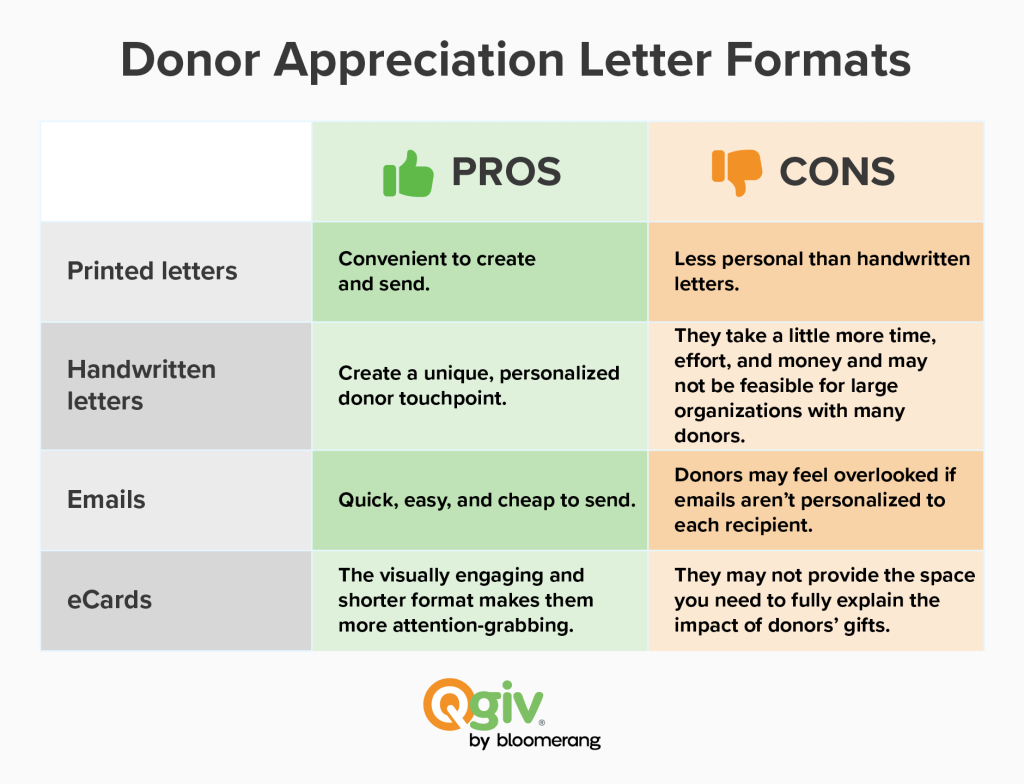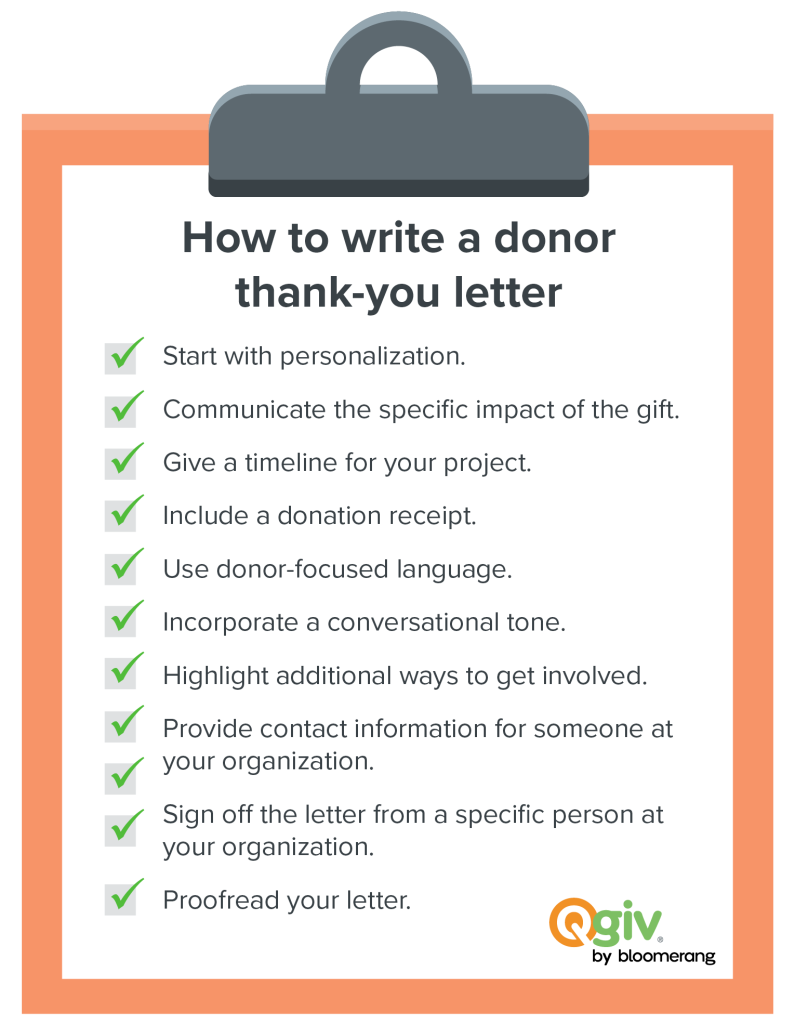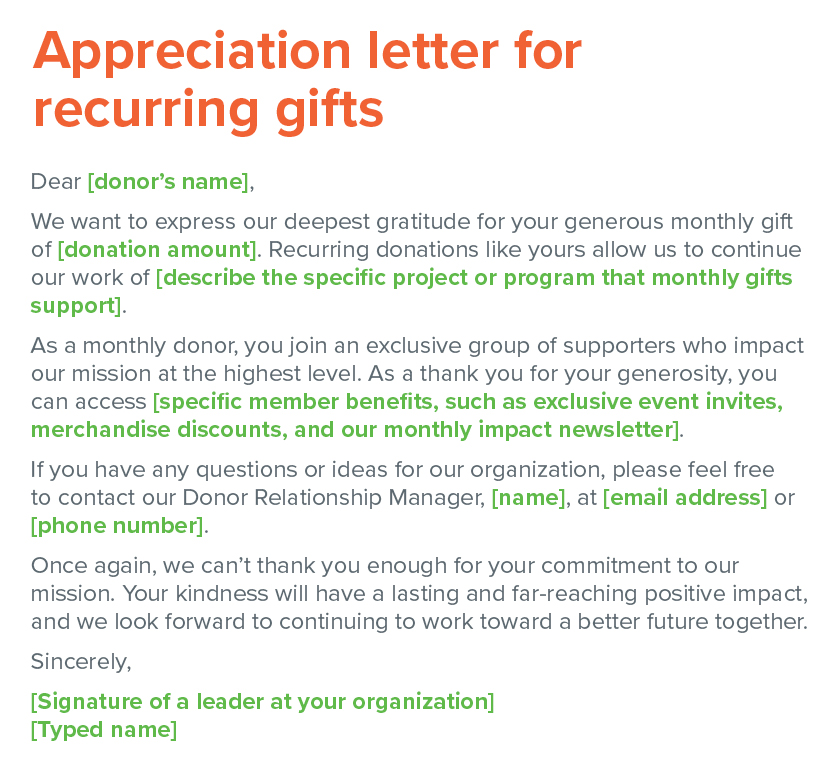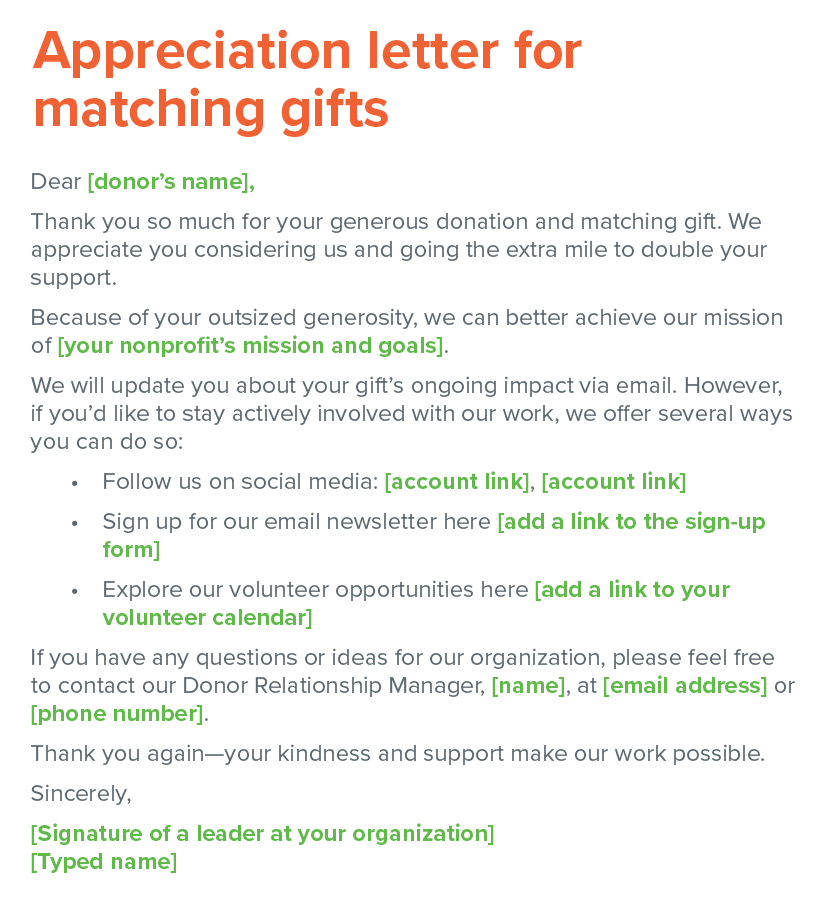Just saying the magic words “thank you” can mean the difference between a donor who gives a single gift and a supporter who feels connected to your organization and consistently contributes to your campaigns.
In fact, studies show that 45% of donors said it was an outstanding thank-you letter that inspired them to give again. With that in mind, this guide explores everything you need to know to write a compelling donor thank-you letter that inspires ongoing giving, including:
- Benefits of donor thank-you letters
- Types of donor appreciation letters
- How to write a compelling donor-thank you letter
- Best practices for thank-you letters for donations
- Thank-you letter examples and templates

Benefits of donor thank-you letters
Improved donor relationships
Every time they donate, your donors put their faith and trust in your organization. It’s important to cultivate these donor relationships to keep them thriving. Saying thanks is one of the easiest ways to reach out to your supporters and make them feel appreciated.
When you acknowledge their contributions, donors feel closer to your organization, and you’ll establish deeper relationships with them. Donor thank-you letters also help develop open communication with your supporters to send updates and information on future campaigns.
Increased donor retention
Thanking donors for their contributions is one of the most effective retention strategies. In fact, studies have suggested that sending personalized thank-yous can increase donor retention rates by up to 39%!
When supporters feel their contributions are making a difference and being recognized, they’ll feel appreciated and more likely to give again.
Enhanced public image
Your nonprofit works hard to accomplish great things in your community. Donor thank-you letters show your supporters that you care about them just as much as they care about you and your work.
When you send a heartfelt thank-you, your supporters will be more likely to talk about how appreciated your organization made them feel and spread the word about the work you do. You can also use social media posts to publicly show your love for your donors through general gratitude messages and specific donor shout-outs.
Types of donor appreciation letters
Donor appreciation letters come in different forms and are sent for various reasons. Let’s explore a few common types of donor appreciation letters and scenarios in which you’d want to send these messages.
Formats
You have multiple options for the format in which you want to send your appreciation letters. Consider the following common structures and the pros and cons of each to choose the right format for your nonprofit:
- Printed letters. Printed letters sent through direct mail are a classic way to contact and acknowledge your donors. They allow you to standardize your communications and send messages out quickly.
- Pros: They’re convenient to create and send.
- Cons: Typed letters are slightly less personal than handwritten letters.
- Handwritten letters. Handwritten letters offer a personal touch, letting donors know you’re thinking about them. This strategy is especially effective for major donor gratitude messages because it shows these supporters that you recognize their monumental impact on your mission.
- Pros: They create a unique, personalized donor touchpoint.
- Cons: Handwritten letters take a little more time, effort, and money and may not be feasible for large organizations with many donors.
- Emails. Email is one of the most common ways to send donor thank-you letters because you can automatically send them right after donors give, ensuring that your thank-you letters don’t fall through the cracks.
- Pros: Emails are quick, easy, and cheap for your nonprofit to send.
- Cons: Donors may feel overlooked if your emails aren’t personalized to each recipient.
- eCards. eCards are electronic greeting cards that your nonprofit can use to show appreciation. They include a short message and an image related to your mission.
- Pros: eCards tend to be more visually engaging than long emails with lots of text, and their shorter format makes them more attention-grabbing.
- Cons: eCards may not provide the space you need to fully explain the impact of donors’ gifts.
The appreciation letter format you choose will ultimately depend on your nonprofit’s budget and your audience’s communication preferences. Remember that you can use multiple formats to thank donors more than once. In fact, we recommend this approach to drive home your point more effectively. A handful of different appreciation messages allows you to keep donors informed about their impact and stay on their radars.
Types of gift acknowledgments
In addition to varying formats, your organization should consider the specific situations requiring thank-you messages. Using a tailored strategy to acknowledge different gift types lets you tailor your thank-you notes to each donor’s unique impact.
Here is an overview of the types of different gifts that require unique acknowledgments:
- Online donations via your online donation form
- Mail-in donations
- Pledges
- Recurring gifts
- Matching gifts
- Planned gifts
- Major gifts
- Gifts of stock
- In-kind gifts
- Corporate sponsorships
In a later section, we’ll review a few tailored gift acknowledgments for different types of gifts.

How to write a compelling donor-thank you letter
1. Prioritize personalization.
Your introduction and greeting are the first pieces of information your donors will see. Start strong with personalized content to ensure they read the whole message.
Use these strategies to personalize your greeting and your letter’s main content:
- Use supporters’ preferred names. Your donor thank-you letter should never start with an impersonal greeting like “Dear Donor” or “Dear Friend.” Instead, use your supporter’s preferred name. For example, if a donor’s name is William, but he goes by Bill, address him as Bill.
- Personalize your thank-yous with the type of donation the donor made. As mentioned, we recommend creating different thank-you letter templates for different gifts, such as online donations, pledge donations, fundraising event gifts, sponsorships, and tribute gifts. These unique touches show that your organization cares about donors’ unique contributions.
- Reference donors’ past involvement. Besides referring to previous donations, referring to other experiences you’ve shared with a supporter is another personal touch you can add to your acknowledgments. If they’ve volunteered for your organization, thank them for how helpful their assistance was. Or, if they’ve been to a fundraising event before, mention the event they’ve participated in and how you were honored by their attendance. This is also an excellent opportunity to mention any volunteer or event opportunities that are coming up for your nonprofit.
2. Communicate the specific impact of the gift.
A donor thank-you letter is the perfect medium for telling a story that will remind supporters why they gave in the first place. Incorporate the following types of content to convey donors’ impact:
- Personal success stories from people who your organization has supported
- Updates on current projects
- Plans for future initiatives
These stories are great ways to connect with your supporters and show them how you’re using their contributions. Stories also shift the focus of the acknowledgment off of your organization and onto your donors and the people, animals, and/or communities you serve.
3. Give a timeline for your project.
Give donors an update on your campaign’s progress toward your fundraising goal. By reminding your supporters how close you are to your end goal, you can create a sense of urgency that inspires donors to give more without your organization specifically asking for another donation.
Consider including a fundraising thermometer in your thank-you letters to emphasize how close you are to the campaign goal.
4. Include a donation receipt.
Your donor thank-you letters can also double as tax receipts. Include pertinent tax information at the bottom of your thank-yous, including your organization’s name, federal tax ID number, and a statement proclaiming your organization as a registered 501(c)(3). Supporters use tax receipts to claim deductions on their tax returns, so as long as the required information is included somewhere in an email or letter, they can use it as proof of the donation.
5. Use donor-focused language.
A donor-centric acknowledgment helps encourage donors to give again in the future. Your organization couldn’t complete its mission without the generosity of all your supporters, so be sure to acknowledge your donors and highlight their contributions.
Instead of discussing your organization’s accomplishments, tell supporters how they’re helping your nonprofit achieve its goals.
Additionally, when communicating with supporters, address donors in the second person pronoun (“you”), and make sure you use “you” more than “we” and “I.” For example, you may say something like, “Thanks to your generosity, hundreds of students now have the supplies they need to start the school year strong.” Your donor thank-you letters should show your supporters that your organization appreciates them individually, not as part of a nameless, faceless group.
6. Incorporate a conversational tone.
Use a warm and personal tone in your donor thank-you letters to cultivate connection and make donors feel like they are part of your nonprofit’s family. Donors who feel a connection to your nonprofit will be more likely to donate again in the future.
Part of keeping a conversational tone in your acknowledgments means guaranteeing that your donors understand what you’re thanking them for. Avoid any complex jargon in your thank-you letters so supporters can understand your thanks without looking up the meaning of specific terms. Use broader phrases for more specialized aspects of your organization’s work.
7. Highlight additional ways donors can get involved with your mission.
Within your donor thank-you letters, don’t be afraid to tell your supporters about other ways they can engage with your organization. For example, you can encourage donors to:
- Volunteer
- Attend free events
- Explore corporate giving programs
Informing donors of how to stay in contact with your nonprofit helps retain your supporters. Offering other engagement opportunities encourages your donors to interact with your organization beyond the dollars they contribute, allowing them to be more closely connected to your work.
8. Provide contact information for someone at your organization.
Donors may have various questions, so provide the name, phone number, and email of a staff member who supporters can contact at your organization.
By providing contact information, your nonprofit will seem more approachable to your supporters. Instead of being a faceless organization, you can show donors you want to hear from them by connecting them with a real person at your nonprofit.
9. Sign off the letter from a specific person associated with your organization.
Your donor thank-you letter should be signed by someone high up in your organization, like your executive director, a board member, or a department head. A signature from a significant leader establishes authority and legitimacy for your acknowledgment. It also makes donors feel appreciated on a more personal level.
10. Proofread your letter.
Once your donor thank-you letters are complete, check your writing for mistakes. Before you send out your letters, read and reread them with a detail-oriented eye. Run your letters through your spell check, and double-check any donor information to ensure everything is correct. In addition, have another person look over your letters before sending them because it’s easy to miss mistakes when you’ve been reading the same thing repeatedly.

Best practices for thank-you letters for donations
Grab donors’ attention immediately and creatively.
To capture your supporters’ attention, make your introduction compelling. Start with an introductory remark that draws your reader in and includes the specifics of your campaign.
Even though some information must be included in your donor thank-you letters, you have creative license throughout the acknowledgment. Donors don’t want to read a dry, cookie-cutter thank-you note, so don’t start with boring cliches like “On behalf of” or “Thank you for your generous contributions.” The more creative you can make your messages, the more likely you will capture your supporters’ attention and the more memorable you’ll be!
Segment your donor list.
Your donor base isn’t a faceless collective. Each person’s relationship with your organization warrants a personal approach. Segmenting your list helps you individualize your acknowledgments before you start writing. You’ll still have to personalize each template before sending them, but writing multiple drafts for various situations ensures your thank-you notes will always be relevant and specific.
Split your list of supporters into first-time donors, recurring donors, major gift donors, and any other significant groups. Write a thank-you letter template for each group based on their unique contributions to your organization. Although you want your templates to be situationally specific, don’t make them so specific that you can’t personalize them by simply filling in your supporters’ personal information.
Automate the thank-you process.
Certain online donation platforms, like Bloomerang, allow your nonprofit to automate your donor thank-you emails. Email acknowledgment software can streamline your thank-you process and reduce the time it takes to send many donor emails. Combining automation software with your donor segmentation will help ensure your emails come across as more personal and genuine.
With Bloomerang’s marketing and engagement tools, you can:
- Create fully branded and customized email campaigns and templates.
- Leverage segmentation to personalize communications.
- Schedule emails to be sent at the opportune time, such as right after a donor submits an online gift.
- Track email metrics like open and click-through rates to assess their effectiveness.
- Create personalized letters and mailings in addition to digital communications.
- Fine-tune your messages with a readability and donor-centricity test.
- Send donor surveys to evaluate your audience’s sentiment toward your nonprofit.
Request a Bloomerang demo today to see how these features can benefit your nonprofit’s donor stewardship and appreciation strategies.
Choose the right format for your nonprofit’s needs and capabilities.
Your organization has many options for thanking supporters. You can send letters by mail or email, make a phone call, or post on social media. With so many choices, you should tailor your approach to your organization’s needs and donors’ preferences. That way, your thank-yous will be manageable on your organization’s end and well-received by your supporters.
Different supporters will interact with your nonprofit in different ways. That’s why choosing the right type of communication for your acknowledgments matters. Make sure to consider:
- Your organization’s size: While big nonprofits might not have time to handwrite all letters, it might be worthwhile for a smaller nonprofit with a growing base.
- Your donors’ preferred communication channels: A younger, tech-savvy base might prefer email or social media, while other donors might prefer a handwritten letter or phone call.
- Gift size: While you should thoughtfully acknowledge contributions of all sizes, major gift donors deserve a more personalized approach.
- Your available resources: If you have a tight budget, it’s more cost-effective for you to use email.
Remember to make your acknowledgments exciting by occasionally shaking things up and sending a different type of thank-you message.
Don’t immediately ask for another donation.
You wouldn’t give your friend a thank-you card letting them know how much you appreciate the birthday gift they got you that includes a list of presents you want for next year. Don’t do the same thing to your supporters! Remember, your donors want to feel appreciated.
While you want to encourage your supporters to further communicate with your nonprofit and donate multiple times, you don’t want them to feel that money is all your organization cares about. Your letter should be donor-centric and appreciative. Focus on the donor’s generosity and hold off on making any further asks.
Brand your acknowledgments.
Your thank-you letters should be cohesively branded to match your nonprofit’s branding. Ensure the letterhead and photos you use match the rest of your campaign or your organization’s overall look so that your supporters will have no doubt whose letter they’re reading.
Keep your donor thank-you letters short.
Your donor acknowledgments shouldn’t be multiple pages long. In fact, the shorter, the better! Keep your donor thank-you letters on one sheet of paper if you can. Donors don’t need to be overwhelmed with an envelope stuffed with information or an email that takes up their full screen.
Donation thank-you letter examples and templates
To get your acknowledgments out quickly, create templates during the campaign’s planning phase. We’ve compiled a short list of templates below based on different giving scenarios that your nonprofit can use.
ChatGPT is another great tool for creating templates. Our ChatGPT fundraising guide offers examples of prompts and strategies for drafting reusable email templates. Just be sure to personalize templates to your nonprofit’s unique mission.
Donor-thank you letter for a one-time campaign donation
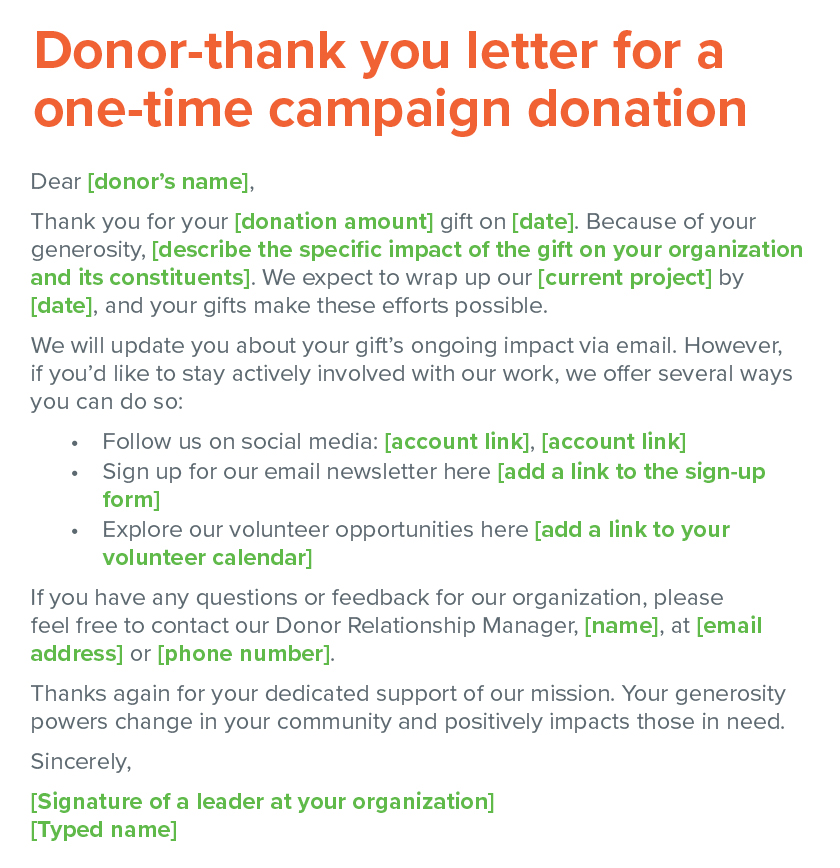
Appreciation letter for recurring gifts
Thank-you note for in-kind donations
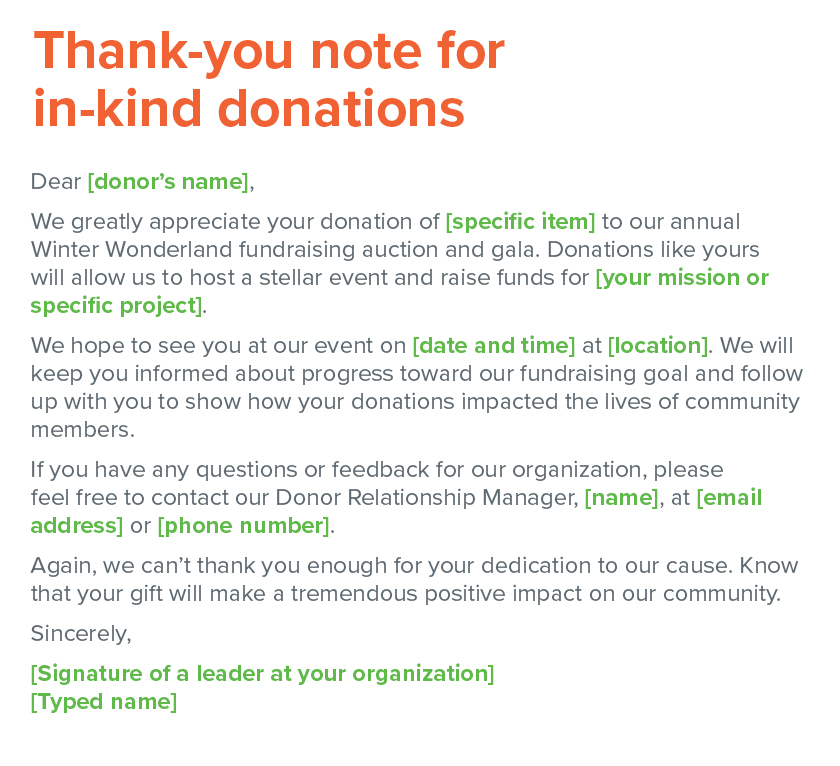
Appreciation letter for matching gifts
Final thoughts
Donor thank-you letters are a crucial step for every fundraising campaign. People want to feel appreciated for the time and money they spend helping others. Acknowledging your donors is key to higher retention rates and increases the possibility of obtaining larger gifts in the future. Recognize your supporters as the heroes of your cause to help your organization’s fundraising efforts grow.
Looking for additional supporter stewardship and acknowledgment resources? Start here:
- Donor Stewardship: Key Tips to Build Relationships. Your appreciation letters are just one element of your large donor stewardship strategy. Use the expert tips in this guide to build well-rounded, long-lasting relationships.
- 12 Donation Request Letter Templates to Help Raise More. Your organization should send donation requests regularly in addition to gratitude messages. Use these templates to structure your requests effectively and raise more.
- Email Marketing for Nonprofits: The Ultimate How-To Guide. Email is a common way to not only send donor thank-you messages but also a variety of other key information supporters need to know. Use this guide to perfect your email marketing strategy.

